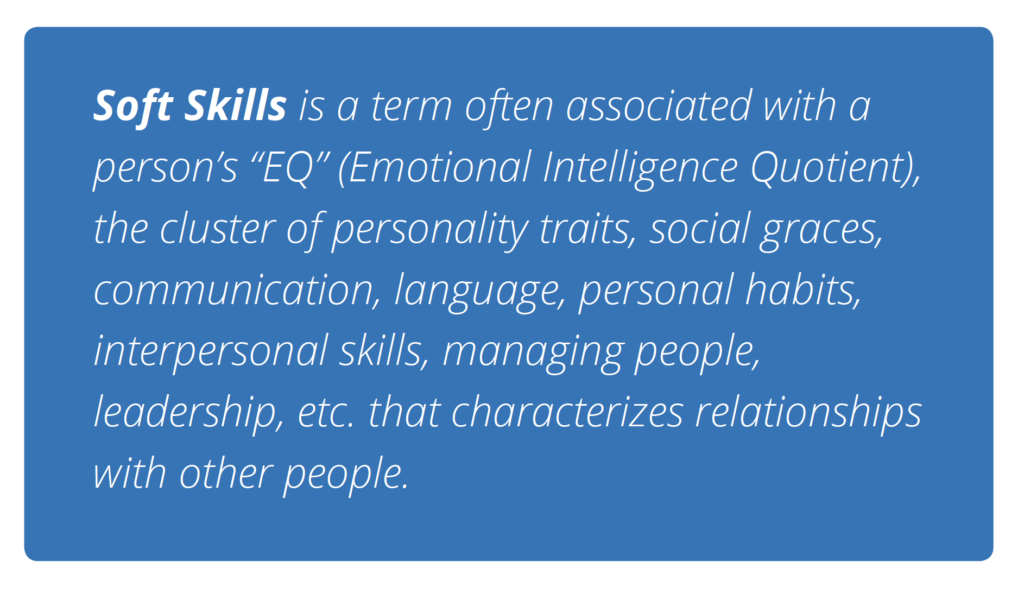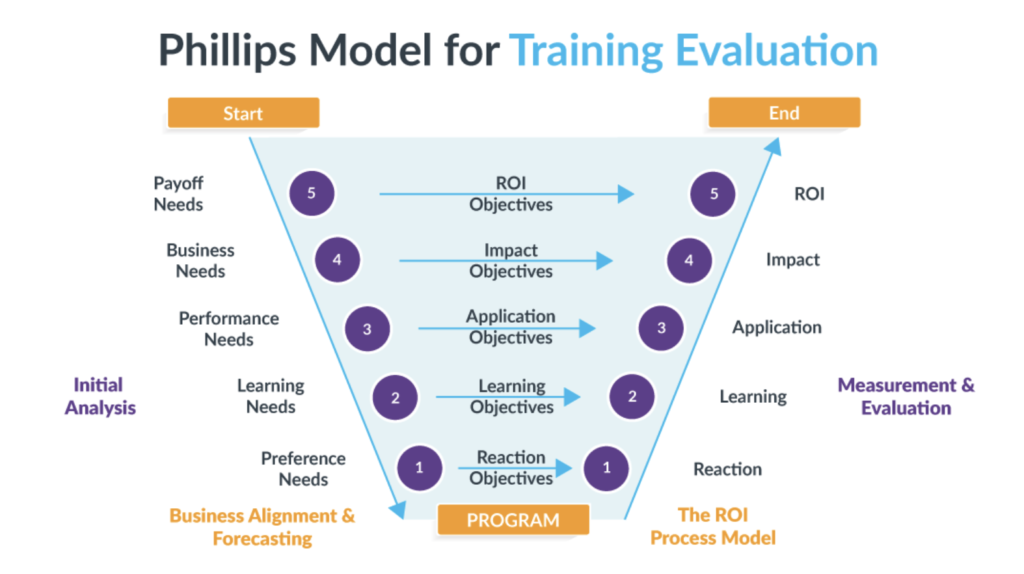Soft skills, that elusive set of personality traits that are essential for team collaboration, effective communication, and good leadership, are often overlooked when companies consider employee training programs. But it’s a mistake to ignore the impact that soft skills – good or bad – can have on your company. If your employees lack essential soft skills it can hurt your bottom line. We spoke with world-renowned expert on employee accountability, measurement and evaluation Dr. Jack Phillips about how to evaluate soft skills training programs and how good soft skills can make your organization more successful.
Q. Why are soft skills training programs critical to an organization’s success?
 Jack J. Phillips, Ph.D: There are many reasons soft skills are crucial. Consider why some companies are featured in publications such as Time orFortune as “the best place to work,” or the “most admired,” or “most innovative.” Companies receive these accolades because they practice and encourage soft skills. What makes a company a great place to work? It’s all about the work environment: does the company encourage employee input, motivate employees, recognize good work, and encourage teamwork and collaboration? It isnot difficult to make the case that soft skills are every bit as important as hard skills are to the success of any organization.
Jack J. Phillips, Ph.D: There are many reasons soft skills are crucial. Consider why some companies are featured in publications such as Time orFortune as “the best place to work,” or the “most admired,” or “most innovative.” Companies receive these accolades because they practice and encourage soft skills. What makes a company a great place to work? It’s all about the work environment: does the company encourage employee input, motivate employees, recognize good work, and encourage teamwork and collaboration? It isnot difficult to make the case that soft skills are every bit as important as hard skills are to the success of any organization.
The problem is that most organizations undervalue soft skills. They focus on developing engineering and technical skills first and put soft skills assessment and development aside, often indefinitely. But if your company does not treat soft skills as the valuable commodity they are, you might wind up with a workplace where people have a hard time communicating and collaborating – and as a result an organization that doesn’t function very well.
A company that invests the time and effort to foster and develop its employees’ soft skills will have a competitive advantage over those that don’t. Take the process of creating new products; soft skills are critical to innovation. Just because you’ve hireda group of technically astute engineers and scientists doesn’t mean your company will be innovative and succeed in developing something groundbreaking. You must provide an environment that encourages people at all levels of theorganization to brainstorm, generate new ideas, and make suggestions that improve your systems. You also need to have a system in place that rewards employees when they make a significant contribution.
Soft skills drive innovation as surely as technical skills do. That is why you must leave enough time and budget for good soft skills training programs.
Q. When do organizations realize they need soft skills training?
Dr. Phillips: It often comes up when the company sees a problem in employee behavior that needs addressing. For example, we once worked with a company that wanted to assess its leadership development training. The
CEO told us, “We have annual ratings of leadership from employees and those ratings have not improved in a long time. We have been investing in leadership development for several years. What is going on?”
In this case, which is common, the company was beginning to question the effectiveness of its current leadership training efforts because employees continued to give leadership poor ratings. As a result the company reassessed how it handled leadership training and how it measured its success.
Let’s take another common problem area: customer service. If there are too many customer complaints, it could mean the companyneeds to invest in soft skills training programs for its customer-facing employees.
Or a company might notice that employees are not supporting each other – they are not sharing knowledge or collaborating as much as they should — which is resulting in errors and waste or missed deadlines. A soft skills training program focused on team building could help in this situation.
Q. How can an organization link soft skills training to an improvement in business measures?
Dr. Phillips: We assess whether a company will benefit from soft skills training by determining whether the end result of the training will satisfy one or more business goals.
The process starts with the company describing to us a problem or unwanted behavior. For instance, the client might think it needs more collaboration between departments; better communications; better customer service; better employee engagement; or higher leadership ratings from employees. At the same time, the client might be seeing some type of undesirable employee behavior.
The next step for us is determining, with the company’s input, the desired behavior. The final step is to identify how the desired behavior would help the company attain a business goal. For instance, we might ask the client, “If your XYZ team made its ABC deadline every time, how would that affect your business?”
I’m reminded of a request we received from an organization to assess its need for a team-building program. We asked the coordinator, “What employee behavior leads you to believe team building is the answer?” The coordinator responded, “Ourpeople work in silos and don’t collaborate or help each other. There’s very little conversation going on among our teams; this is because they don’t get along very well.” These were clear problems in need of a fix. We then asked: “How is this situationaffecting your department? How is it affecting your business?”
The answers to these questions help us determine what is important to the organization. To continue with the previous example, management might say that the teams who aren’t speaking to each other aren’t completing projects on time and that’s costing the company business with important clients. Or perhaps employees are unhappy with a particular boss’s communication style and that is causing people to transfer out of the department. We’ve now identified two very specific business goals—productivity and reducing internal employee turnover —that can be addressed with a soft skills training program. We’ll use this information that we’ve gleaned from interviewing key staff to help establish clearly stated and measurable learning objectives, and these objectives will set an expectation for the level of information, knowledge, or skills that people are expected to gain. If an organization can’t identify the business goals it wants to meet through training, we probably won’t take on the project.
Q. How Can an Organization Measure the Success of Soft Skills Training?
 Over many years and projects we’ve developed a recognized methodology to measure the success of soft skills trainingprograms. We measure results in five levels: participant reaction to the training, skills learned, actions taken, changes in business results, and return on investment. (Depending on your needs you might not need to measure all five levels.)
Over many years and projects we’ve developed a recognized methodology to measure the success of soft skills trainingprograms. We measure results in five levels: participant reaction to the training, skills learned, actions taken, changes in business results, and return on investment. (Depending on your needs you might not need to measure all five levels.)
Level 1: Measuring Reaction
Determining the value of any soft skills training program starts with collecting data that gages the participants’ reaction to the training and the changes they plan to make when they go back to work. To collect this information, we typically distribute a survey immediately after the training. We ask participants: Did you find the training relevant? Will you use the new skills you learned when you resume working?
It’s important to note that although this level of evaluation is important, it’s only the first step. Next, we’ll find out how much participants actually learned.
Level 2: Measuring Learning
In the second step of our process, we determine how much participants actually learned from the team- building or leadership training. We do this by assessing the skills, knowledge or attitude changes the training was designed to teach, based on thecompany’s desired business goals.
For example, after a team-building course we might expect the participants to be able to:
- Name three new communications skills and techniques;
- List five ways to collaborate;
- Explain the three ways to break down silos;
- Describe the positive effects teamwork has on company culture;
- Demonstrate the 5 Steps to positive conflict resolution.
- Level 3: Measuring Application & Implementation
Here’s where the rubber starts gripping the road – how are employees applying their new skills and knowledge to their jobs?Participants’ behavior should change after they return to the workplace and begin to use what they learned during training. The information gained from a soft skills training program might include the use of new skills in communication, conflict resolution, or leadership. These new skills can have a big effect on important areas of business such as reducing errors and waste, decreasingemployee turnover or improving employee satisfaction scores.
Here are a few examples of application objectives we might set out for Level 3 assessment:
- Within three weeks, participants will join a cross- functional team composed of managers from marketing, sales, engineering, and product development;
- Within three months, new cross-functional teams will establish new processes to meet deadlines;
- Participants will use conflict resolution skills each time a conflict arises;
- Participants will use collaboration skills each day.
Levels 4: Measuring Changes in Business Impact Variables
In this phase, we measure changes in business impact variables, such as productivity, quality, time, and costs linked to the training program. A step is taken to discover if the soft skills training reduced the level of errors and waste, helped improve productivity, and reduced transfers out of the department. After full implementation and within one year, we should expect the following:
- Employee productivity will increase by 10%;
- 90% of all product release deadlines will be met;
- Departmental employee satisfaction scores will improve from an average of 3.1 to 4.0 on a five-point scale;
- Internal employee turnover will decrease by 30%;
- Cross-functional teams will introduce at least two new products into the development pipeline.
Step 5: Measuring Return on Investment
Return on investment compares the monetary value of the impact results with the cost of the program, usually expressed as a percentage. If you do the upfront work, determine your needs, set clear and measurable objectives for learning and implementation, and determine which business impact measures should be affected by a soft skills training program, then youwill be prepared to progress to whatever depth of assessment your organization requires, including a financial returns analysis.
For more detailed reading on the Phillips ROI methodology, please visit the ROI Institute website: www.roiinstitute.net.
###
Jack J. Phillips, Ph.D. is a world-renowned expert on accountability, measurement, and evaluation. Phillips providesconsulting services for Fortune 500 companies and major global organizations. The author or editor of more than 75 books, he conducts workshops and speaks at conferences worldwide. His expertise in measurement and evaluation is based on more than27 years of corporate experience in the aerospace, textile, metals, construction materials, and banking industries. Dr. Phillips has served as training and development manager at two Fortune 500 firms, as senior human resources officer at two firms, aspresident of a regional bank, and as management professor at a major state university. Dr. Phillips holds undergraduate degrees in electrical engineering, physics, and mathematics; a master’s degree in decision sciences from Georgia State University; and a Ph.D. in human resources management from the University of Alabama. His work has been featured in The Wall Street Journal, Bloomberg BusinessWeek, Fortune, and on CNN.
Contact Dr. Phillips at: jack@roiinstitute.net
About UpSkill California
The UpSkill California consortium is composed of more than 30 California Community Colleges that deliver customized employee training and workplace education via Workforce Training & Development Centers (WTDC). The Centers receive support from the Employment Training Panel (ETP)—a state agency that provides funding to employers to assist in upgrading the skills of their workers through training. ETP funding helps off-set the costs of job skills training necessary to maintain high-performance workplaces.
To help businesses manage and administer the complexities of ETP contracts, several of our college members are designated as Multiple Employment Contract (MEC) holders. Those colleges also assist other consortium members in procuring ETP contracts for their clients, thus expanding the geographic area served by ETP. Colleges that are MECs are identified in the list below. Non-designated colleges subcontract with MEC colleges to procure ETP funding for their clients. Find the Workforce Training & Development Center in your region.
About the author: Jon Wollenhaupt is president of Go Launch Marketing. He writes extensively on topics related to digital marketing, employee training, corporate learning, and professional development. He can be reached via email at jon@golaunchmarketing.com.



Comments are closed.